
How to Succeed in Outbound Prospecting Strategies

Outbound prospecting continues to be valuable; it has simply adapted to the evolving demands of today’s competitive B2B landscape.
Many businesses struggle to convert cold outreach into meaningful conversations, leading to wasted time, missed opportunities, and low-quality leads that don’t generate revenue.
So, what makes outbound prospecting effective now?
This guide will break down what modern outbound prospecting looks like. You’ll learn strategies rooted in relevance and authentic connections, helping you spark interest, get responses, and build sales pipelines that don’t depend on luck.
What is Outbound Prospecting?
Outbound prospecting has evolved with the times. Today, modern strategies emphasize targeted, insight-driven outreach where personalized engagement plays a central role.
The focus is on initiating meaningful conversations with the right prospects through carefully crafted emails and well-timed appointment scheduling.
Instead of relying on volume-based outreach, the shift now focuses on value-based targeting, where relevance takes priority over reach. Cold calls are no longer the main focus, and teams are turning to smarter approaches, such as tailored email campaigns that consider buyer intent, industry relevance, and personalized messaging.
This enables businesses to connect with decision-makers more efficiently while avoiding time spent on unqualified leads.
One proven strategy is account-based marketing (ABM), which targets high-value accounts with personalized outreach, boosting lead quality and conversions. See how ABM is reshaping outbound prospecting.
Why should you care about outbound prospecting? Here’s what it brings to the table:
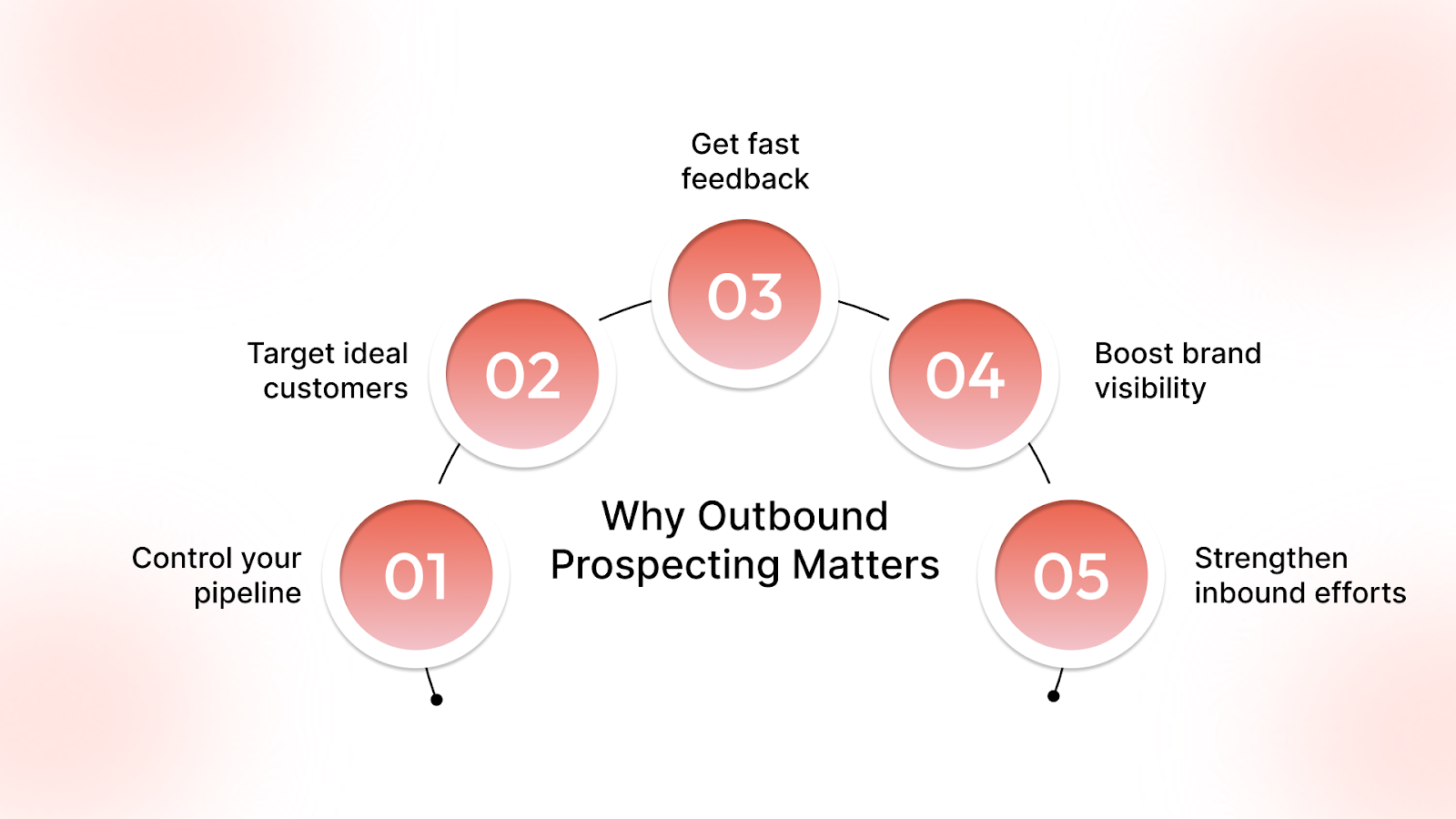
- You stay in control of your pipeline. You don’t have to wait for traffic or inbound leads. You choose who to go after and when.
- It allows precise targeting. You can focus on ideal customer profiles and tailor your message for maximum relevance.
- It brings faster feedback loops. You quickly learn what messaging resonates and what falls flat. No more long waits for inbound analytics.
- It builds visibility and brand awareness. Even if a prospect doesn’t convert now, your outreach gets your name in front of the right eyes.
- It complements your inbound strategy. Outbound doesn’t replace inbound; it strengthens it by filling in the gaps and accelerating momentum.
To boost your reach, drive growth, and spark valuable conversations, outbound prospecting is key. But it takes more than bulk messages; it requires smart planning, sharp messaging, and thoughtful execution.
Let’s explore the strategies that can lead to success
Key Strategies for Outbound Prospecting
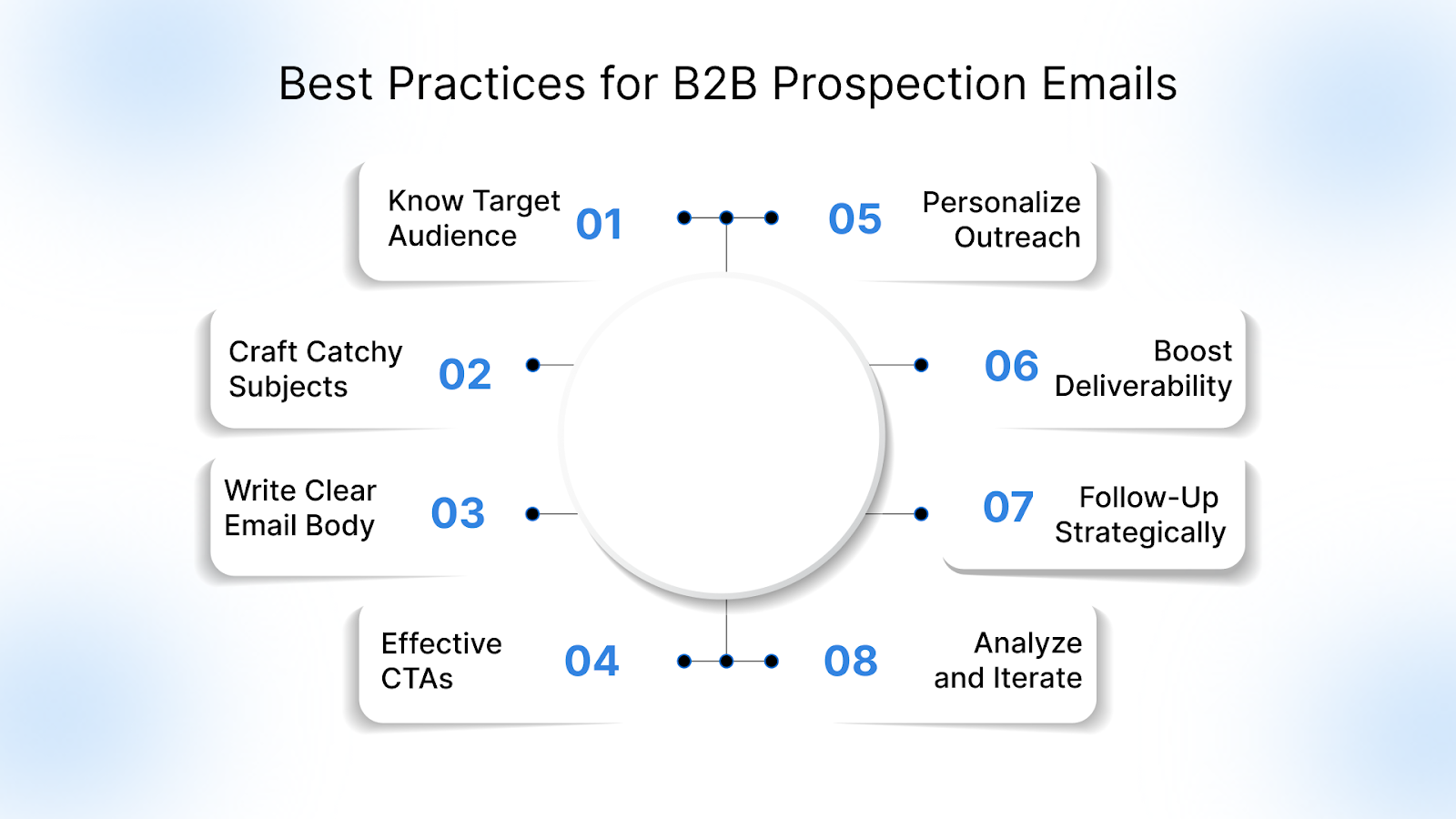
Considering the current competition, just having a great service isn’t enough. You need to put it in front of the right people proactively. That’s where outbound prospecting becomes your growth engine.
Let’s walk through eight proven strategies to help you make every prospecting effort count:
1. Define Your Ideal Customer Profile (ICP)
With B2B email response rates averaging only 2.5%, it's more critical than ever to target the right prospects. A well-defined Ideal Customer Profile (ICP) directs your efforts toward the leads most likely to convert, maximizing both time and resources.
Just 16% of marketers consider outbound practices the most effective for generating high-quality leads, emphasizing the need for a carefully crafted ICP.
How to do it:
- Review your highest-value clients to identify patterns in industry, deal size, and lifecycle stage.
- Focus on verticals with recurring needs, such as MSPs, staffing, and tech companies.
- Align sales and marketing teams to reach consensus on who qualifies as a strong-fit lead.
For insights into building an effective ICP, see how an MSP increased revenue with TLM in our case study.
2. Build a Targeted Prospect List
Once your ICP is crystal clear, it is time to translate that into a targeted prospect list. This list will form the foundation of your campaign, so accuracy is key. Mass emailing irrelevant contacts wastes time and drains your sales pipeline. You need verified names that map directly to your ICP.
How to do it:
- Use platforms like The Lead Market (TLM) to filter by industry, company size, geography, and buying intent.
- Filter by industry, company size, geography, and buying intent.
- Regularly clean and update your lists to avoid outdated or irrelevant contacts. Check here for the best strategies to clean your email list.
3. Personalize Your Outreach
Prospects know when they’re getting a cookie-cutter message. Personalization is not only about using someone's name; it’s about showing them that you understand their business and have a solution tailored for them. It’s the difference between being ignored and being booked.
How to do it:
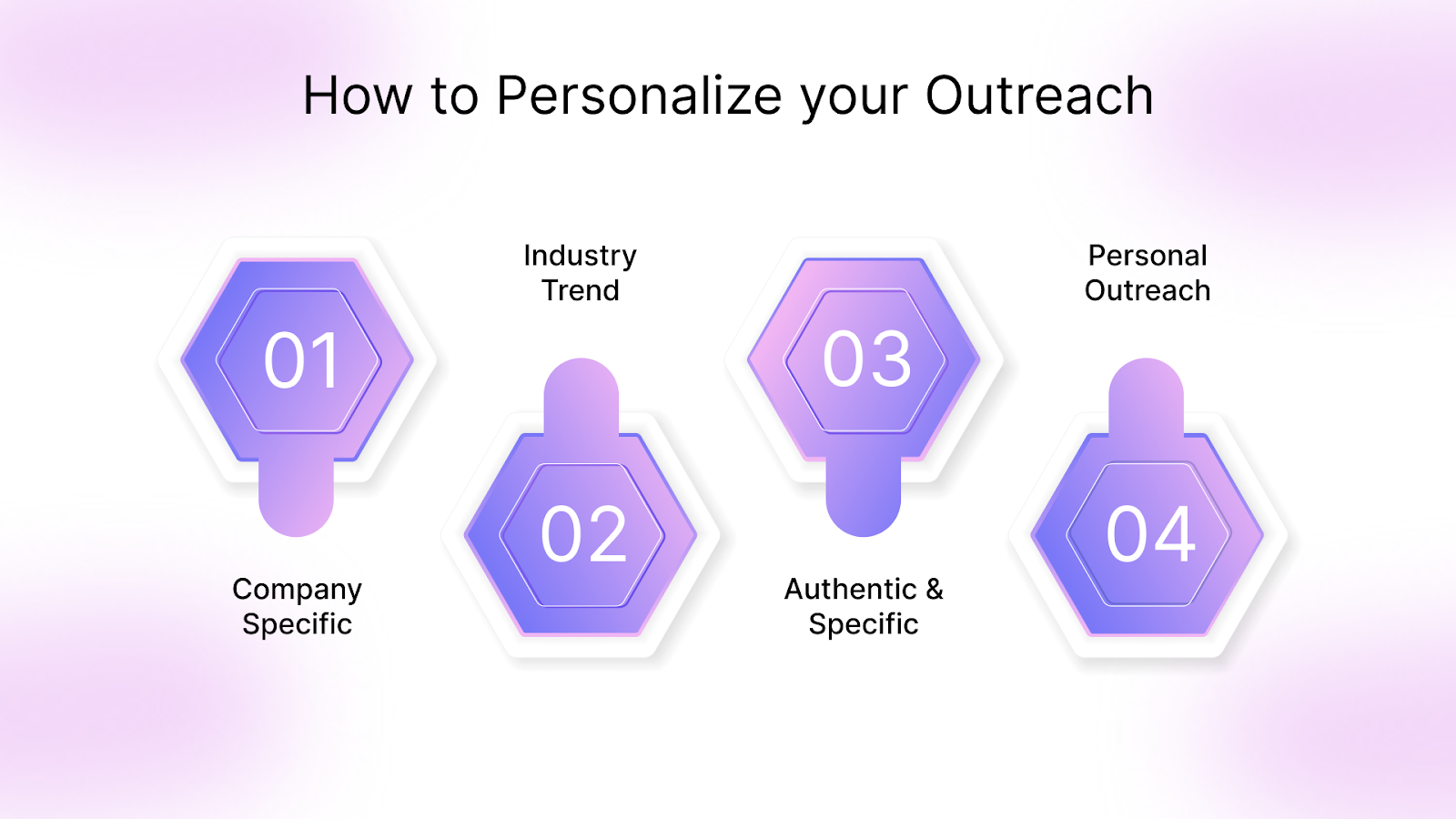
- Reference something unique to the company or prospect.
- Mention a recent industry trend or challenge they may be facing.
- Avoid templates, write with authenticity and specificity.
- Know when not to use automation; some emails deserve a fully personal approach.
4. Implement a Structured Sales Cadence
Outreach isn’t a one-and-done game. You need a cadence, a planned sequence of touchpoints spread over days or weeks. This keeps you at the top of your mind without being pushy. It increases your odds of getting a response without annoying your prospect.
Research indicates that it takes an average of 8 touches to secure an initial meeting with a new prospect. Top-performing sales representatives often employ cadences comprising 8 to 12 touchpoints throughout 2 to 4 weeks.
A well-planned cadence helps nurture prospects without overwhelming them and boosts email marketing ROI.
How to do it:
- Plan 5–7 touches over 10–14 days.
- Focus mainly on personalized emails and timely follow-up calls.
- Space out communication to avoid coming off as spammy.
This method improves response rates and effectively nurtures prospects through the buyer’s journey.
5. Qualify Prospects Early to Maximize Sales Efficiency
Not every lead is ready to buy, so qualifying prospects early saves your sales team time and effort. Focusing on sales-ready leads increases your chances of closing deals and growing Monthly Recurring Revenue (MRR).
How to do it:
- During initial outreach, use clear qualification criteria like budget, authority, need, and timeline (BANT).
- Ask targeted questions to identify sales-ready prospects.
- Pass only pre-qualified leads to your sales team for meetings.
TLM’s Appointment Scheduling team specializes in securing meetings with pre-qualified decision-makers, ensuring your sales pipeline remains focused and efficient
6. Track, Optimize, and Scale Your Outbound Campaigns with Real-Time Insights
Great outbound prospecting doesn’t end after you hit send. To scale what works, you need to track how each campaign performs and adjust accordingly. Monitor key metrics like open rates, replies, and meetings booked. Then refine your subject lines, CTAs, and timing to improve results.
How to do it:
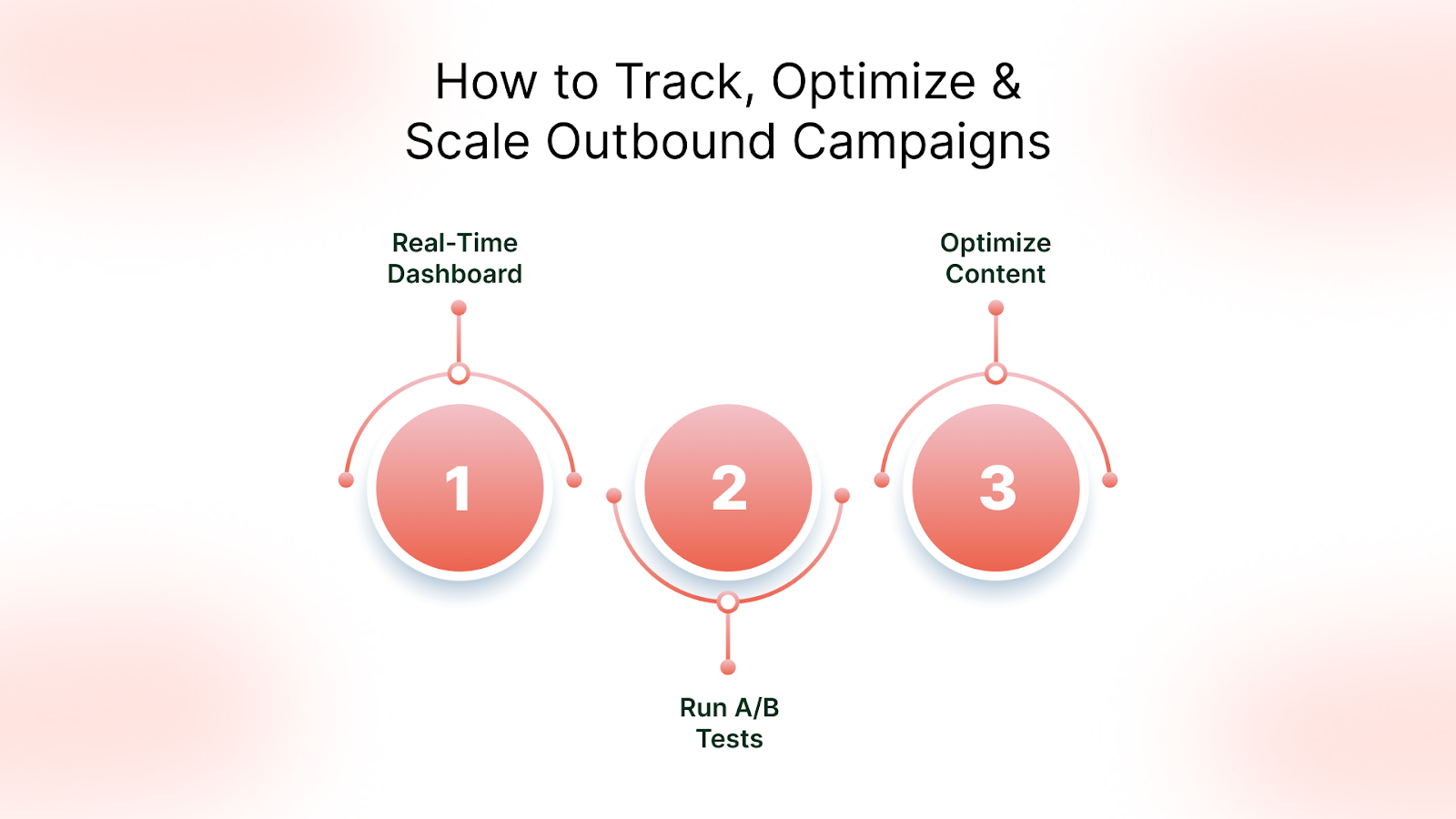
- Use a real-time dashboard to monitor campaign performance.
- Run A/B tests to discover what messaging drives engagement.
- Optimize content for clarity, tone, and mobile responsiveness.
With consistent tracking and small tweaks, your outreach becomes smarter, sharper, and far more effective.
Need ideas that move the needle? Here are 7 outbound lead generation strategies you can start using today.
7. Offer Value in Every Interaction
People don’t open emails to be sold to; they open them to gain something. Every interaction you have should give your prospect a reason to pay attention, whether it’s a useful insight, a new way to solve a problem, or a piece of information that makes their job a little easier.
When you focus on adding value rather than making a pitch, you shift from being “just another salesperson” to a trusted resource. It’s this approach that builds trust and encourages meaningful conversations down the line.
How to do it:
- Tailor your message to highlight how your solution addresses their specific challenges.
- Build rapport first; avoid asking for a meeting too early, and let the conversation flow naturally.
Also Read: Essential Dos and Don’ts of Effective B2B Marketing for Driving Results
8. Reduce Reliance on Cold Calling by Focusing on Warm, Qualified Leads
Cold calling may still have a place, but it’s no longer the backbone of modern B2B prospecting. Instead, focus on warming up leads with value-driven, personalized email campaigns that address real challenges. When your outreach speaks to prospects' pain points, it becomes a conversation starter, not an interruption.
How to do it:
- Identify sales-ready leads with the right fit and intent signals.
- Use email sequences that open with real-world problems and offer clear next steps.
- Reserve calls for qualified prospects who've already shown interest.
A well-designed email strategy, combined with qualification filters, makes cold calls mostly unnecessary, so your team can focus on warm conversations that close.
Effective Outbound Prospecting Strategy Implementation with TLM
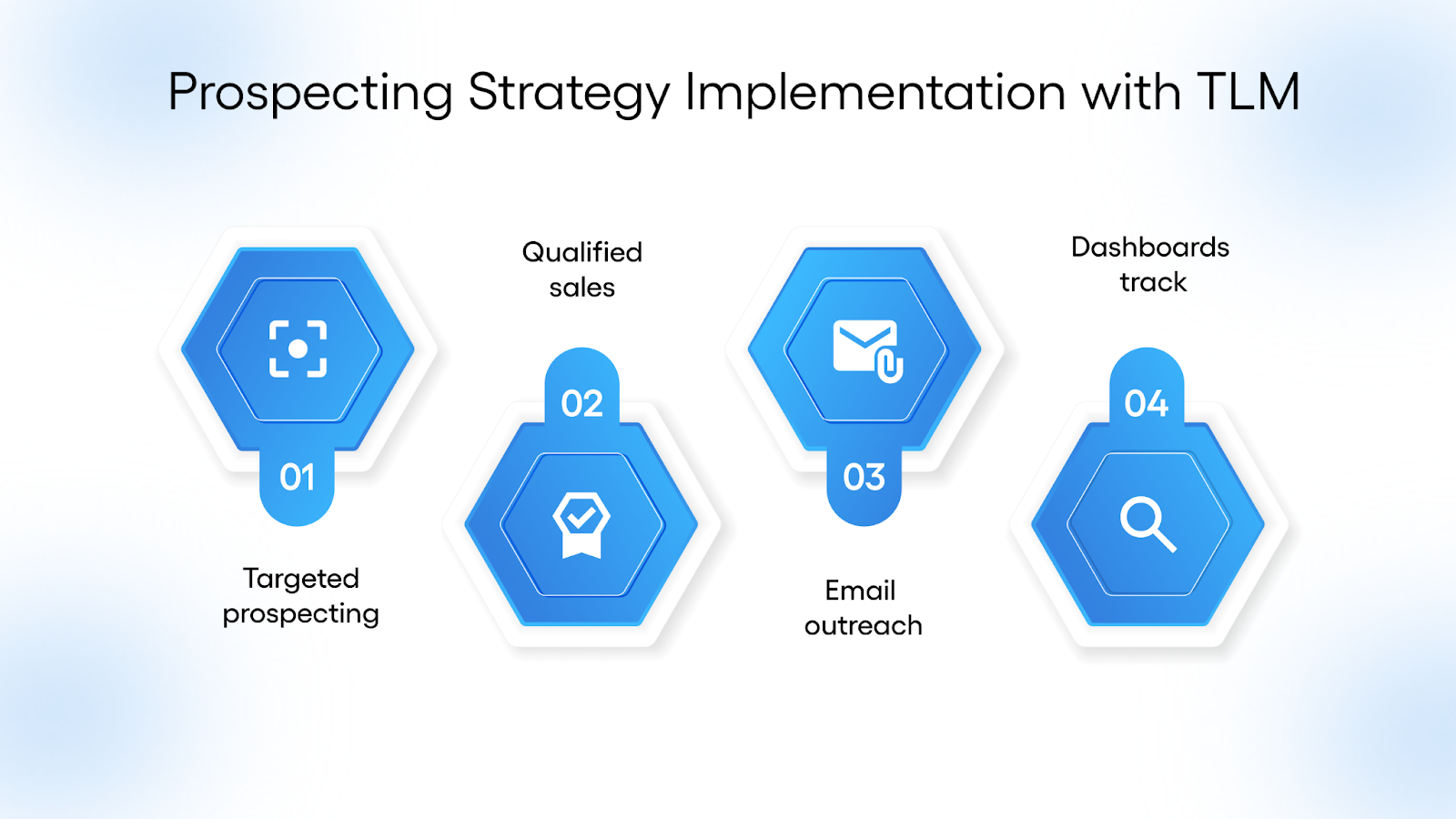
At TLM Inside Sales, outbound prospecting isn’t just about reaching out; it’s about reaching the right people with the right message at the right time. Our proven strategies help B2B SMEs connect with high-value prospects across key decision-making tiers, especially in industries like MSPs, staffing, tech, and manufacturing.
We help you succeed with:
- Hyper-targeted prospecting based on your ICP and industry-specific triggers.
- Custom outreach scripts are designed to convert interest into qualified sales conversations.
- Customized email outreach campaigns designed to convert interest into qualified sales conversations.
- Real-time reporting dashboards that track engagement and outcomes, helping you refine your strategy.
With TLM, outbound prospecting becomes a predictable and scalable engine that drives your sales pipeline forward.
Book a meeting today and see how we can help you generate qualified leads.
Conclusion
Outbound prospecting is far from outdated; in fact, it’s more important than ever. Whether you’re a staffing firm or tech-driven business in the U.S, Australia, or Canada, relying solely on inbound leads just won’t cut it.
The real wins come when you take charge, identify the right prospects, and spark conversations that matter.
The good news? With the right inside sales experts like TLM, data-driven targeting, and a touch of personalization, outbound prospecting becomes a whole lot smarter and far more effective. Stay intentional and consistent, and your pipeline will thank you.
FAQs: Everything else you need to know
1. How long does it take to see results from outbound prospecting?
Most businesses begin seeing early engagement within 2–4 weeks, but consistent results typically show after 60–90 days of refined outreach and follow-up.
2. Should I outsource outbound prospecting or keep it in-house?
Outsourcing to experts like TLM Inside Sales can save time and ensure consistency, especially if you lack a dedicated sales development team or internal bandwidth.
3. How often should I refresh my outbound prospect list?
Review and update your list every 30–60 days to avoid stale contacts, remove bounced emails, and adjust based on market or ICP changes.
4. What’s the best time of day to send outbound emails?
For B2B audiences, emails tend to perform best mid-morning (9–11 AM), as prospects are typically settled into their workday. Sending emails during this window ensures they are seen before their inbox becomes too crowded, increasing the chances of engagement.
5. How can I prevent my outbound emails from landing in spam folders?
Use verified email domains, personalize your content, avoid spam trigger words, and gradually warm up your email-sending activity to build credibility.






